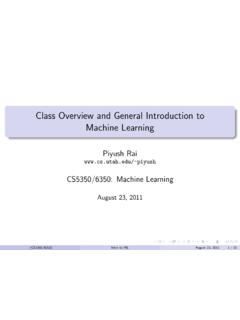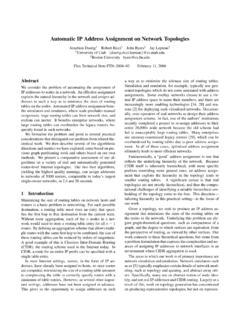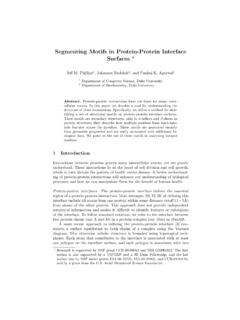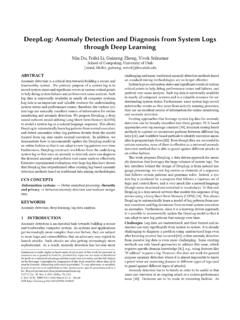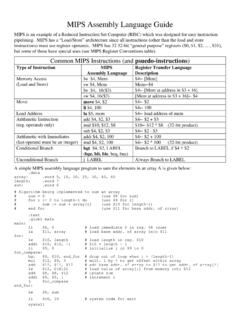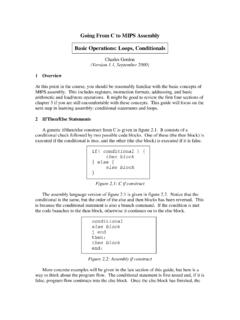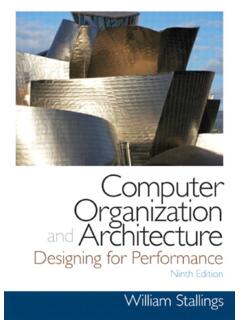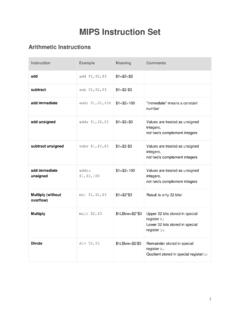Transcription of Lecture 2: MIPS Instruction Set - University of Utah
1 1 Lecture 2: MIPS Instruction Set Today s topic: MIPS instructions Reminder: sign up for the mailing list cs3810 Reminder: set up your CADE accounts (EMCB 224)2 Recap Knowledge of hardware improves software quality:compilers, OS, threaded programs, memory management Important trends: growing transistors, move to multi-core,slowing rate of performance improvement, power/thermalconstraints, long memory/disk latencies3 Instruction Set Understanding the language of the hardware is key to understandingthe hardware/software interface A program (in say, C) is compiled into an executable that is composedof machine instructions this executable must also run on futuremachines for example, each Intel processor reads in the same x86instructions, but each processor handles instructions differently Java programs are converted into portable bytecode that is convertedinto machine instructions during execution (just-in-time compilation) What are important design principles when defining the instructionset architecture (ISA)?
2 4 Instruction Set Important design principles when defining theinstruction set architecture (ISA): keep the hardware simple the chip must onlyimplement basic primitives and run fast keep the instructions regular simplifies thedecoding/scheduling of instructions5A Basic MIPS InstructionC code: a = b + c ; assembly code: (human-friendly machine instructions )add a, b, c # a is the sum of b and cMachine code: (hardware-friendly machine instructions )000000100011001001000000001 00000 Translate the following C code into assembly code:a = b + c + d + e;6 ExampleC code a = b + c + d + e;translates into the following assembly code:add a, b, c add a, b, cadd a, a, d or add f, d, eadd a, a, e add a, a, f instructions are simple: fixed number of operands (unlike C) A single line of C code is converted into multiple lines ofassembly code Some sequences are better than the secondsequence needs one more (temporary) variable f7 Subtract ExampleC code f = (g + h) (i + j); assembly code translation with only add and sub instructions :8 Subtract ExampleC code f = (g + h) (i + j).
3 Translates into the following assembly code:add t0, g, h add f, g, h add t1, i, j or sub f, f, isub f, t0, t1 sub f, f, j Each version may produce a different result becausefloating-point operations are not necessarilyassociative and more on this later9 Operands In C, each variable is a location in memory In hardware, each memory access is expensive if variable ais accessed repeatedly, it helps to bring thevariable into an on-chip scratchpad and operate on thescratchpad (registers) To simplify the instructions , we require that eachinstruction (add, sub) only operate on registers Note: the number of operands (variables) in a C program isvery large; the number of operands in assembly is can be only so many scratchpad registers10 Registers The MIPS ISA has 32 registers (x86 has 8 registers) Why not more? Why not less?
4 Each register is 32-bit wide (modern 64-bit architectureshave 64-bit wide registers) A 32-bit entity (4 bytes) is referred to as a word To make the code more readable, registers arepartitioned as $s0-$s7 (C/Java variables), $t0-$t9(temporary variables)..11 Memory Operands Values must be fetched from memory before (add and sub) instructions can operate on themLoad wordlw $t0, memory-addressStore wordsw $t0, memory-addressHow is memory-address determined?RegisterMemoryRegisterMemory1 2 Memory Address The compiler organizes data in it knows thelocation of every variable (saved in a table).. it can fillin the appropriate mem-address for load-store instructionsint a, b, c, d[10] address13 Immediate Operands An Instruction may require a constant as input An immediate Instruction uses a constant number as oneof the inputs (instead of a register operand)addi $s0, $zero, 1000 # the program has base address# 1000 and this is saved in $s0# $zero is a register that always# equals zeroaddi $s1, $s0, 0 # this is the address of variable aaddi $s2, $s0, 4 # this is the address of variable baddi $s3, $s0, 8 # this is the address of variable caddi $s4, $s0, 12 # this is the address of variable d[0]14 Memory Instruction Format The format of a load Instruction :destination registersource addresslw $t0, 8($t3)any registera constant that is added to the register in brackets15 ExampleConvert to assembly :C code.
5 D[3] = d[2] + a;16 ExampleConvert to assembly :C code: d[3] = d[2] + a; assembly : # addi instructions as beforelw $t0, 8($s4) # d[2] is brought into $t0lw $t1, 0($s1) # a is brought into $t1add $t0, $t0, $t1 # the sum is in $t0sw $t0, 12($s4) # $t0 is stored into d[3] assembly version of the code continues to expand!17 Recap Numeric Representations Decimal 3510 Binary 001000112 Hexadecimal (compact representation)0x 23 or 23hex 0-15 (decimal) 0-9, a-f (hex)18 Instruction FormatsInstructions are represented as 32-bit numbers (one word),broken into 6 fieldsR-type instructionadd $t0, $s1, $s2000000 10001 10010 01000 00000 1000006 bits 5 bits 5 bits 5 bits 5 bits 6 bitsop rs rt rd shamt functopcode source source dest shift amt functionI-type Instruction lw $t0, 32($s3)
6 6 bits 5 bits 5 bits 16 bitsopcode rs rt constant19 Logical OperationsLogical ops C operators Java operators MIPS instrShift Left << << sllShift Right >> >>> srlBit-by-bit AND & & and, andiBit-by-bit OR | | or, oriBit-by-bit NOT ~ ~ nor20 Control instructions Conditional branch: Jump to Instruction L1 if register1equals register2: beq register1, register2, L1 Similarly, bne and slt (set-on-less-than) Unconditional branch:j L1jr $s0 Convert to assembly :if (i == j)f = g+h;elsef = g-h;21 Control instructions Conditional branch: Jump to Instruction L1 if register1equals register2: beq register1, register2, L1 Similarly, bne and slt (set-on-less-than) Unconditional branch:j L1jr $s0 Convert to assembly :if (i == j) bne $s3, $s4, Elsef = g+h; add $s0, $s1, $s2else j Exitf = g-h; Else: sub $s0, $s1, $s2 Exit:22 ExampleConvert to assembly :while (save[i] == k)i += 1;i and k are in $s3 and $s5 andbase of array save[] is in $s623 ExampleConvert to assembly :while (save[i] == k)i += 1;i and k are in $s3 and $s5 andbase of array save[] is in $s6 Loop: sll $t1, $s3, 2add $t1, $t1, $s6lw $t0, 0($t1)bne $t0, $s5, Exitaddi $s3, $s3, 1j LoopExit:24 Title Bullet
